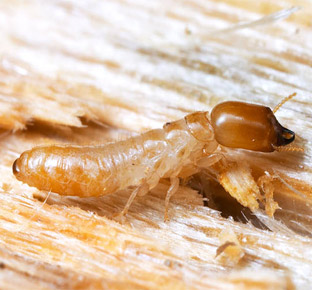
Overview
Termites belonging to the family Kalotermitidae are known as drywood termites. They are considered a primitive group of termites based on their morphology, nesting behavior and social organization.
The most common species found throughout the country and neighbouring country in association with houses, infesting untreated timbers in service are Cryptotermes cynocephalus and Cryptotermes domesticus.
Drywood termites’ legs are shorter than subterranean termites’ legs, and they literally move slower as a result. They are primarily restricted to feeding on drywood and no distinct nest structures are made. Galleries, excavated within the wood, serve as nests. Colonies are usually small. Drywood termite colonies develop slowly. The entire colony may take five years or more to mature.
Responsibilities for reproduction, foraging and colony defense are divided up among castes: reproductives (king, queen and alates), “workers” and soldiers. Eggs may take several months to hatch. Eggs hatch into larvae which undergoes about three molts, the young beginning the process of separating into castes. In drywood termites, the worker caste does not consist of true workers that are reproductively sterile as found in subterranean termites. Worker caste role is assumed by late instar larvae, termed as pseudergates or pseudoworkers. Although morphologically these pseudoworkers are still very larval-like, behaviorally they are very much like the worker caste of subterranean termites. All members of the colony except for the reproductives are blind.
Drywood termites are more commonly recognized by their fecal pellets. These pellets are pushed out of the termite galleries and may build up in small piles beneath the area of infestation. The pellets are about one millimeter in size with six distinctly concave surfaces and rounded ends. Pellets are often the colour of the wood on which the termites are feeding. As with subterranean termites, drywood termites swarm to establish new colonies elsewhere. They are weak fliers and tend to flutter about on the wind as much as actively fly. It is likely that they will not stray too far from the original colony in their dispersal flights.
Drywood termites behave differently from subterranean termites in many respects. They live in very dry, sound wood, require no moisture source or ground contact and create no mud tubes. These termites also tend to have colonies that are very small and slow-growing, generally consisting of a few thousand termites at maturity. Small colony size may confine damage to a relatively small area, however, multiple infestations through swarming is common. Drywood termites build large, sandpaper-smooth galleries that can cut both across and along the wood grain. A paper-thin layer of surface wood is left over the galleries as they feed. Fecal pellets may also be present when the galleries are broken open. Piles of pellets outside the galleries may be the only clue that there is a termite problem.
Drywood termites have the ability to infest both dead wood in trees and wood used in structures. They may also be found in furniture and wood pallets.
Typical signs of infestation include:
1. Shed wings
2. Ejected piles of fecal pellets
3. Smooth galleries inside wood are typical signs of a drywood termite infestation.
4. Swarming alates
Alates commonly enter structures through eaves of roofs, attics, cracks around window or door frames, or cracks in siding. Alates can find a niche in wood that provides optimum conditions for establishing a colony.
Control
A thorough inspection of every part of a structure is crucial in controlling drywood termite infestations. All exposed exterior and interior wood surfaces such as exposed floor areas, furniture, cabinets has to be carefully inspected.
Once the extent of the infestation had been determined, appropriate control measures are taken. The traditional and newer subterranean termite control and prevention strategies are not used with drywood termites. Because colonies are smaller and more isolated, the most common method of control is through the injection of chemicals (dusts, liquids or aerosols) into infested wood.
Alternate to the above would be to carry out fumigation treatment. This is normally carried out if the infestation is widespread, inaccessible or valuable furniture is involved. Prevention of drywood termites is directed at swarmers. All cracks, vents or other openings should be properly screened or caulked.
Services
